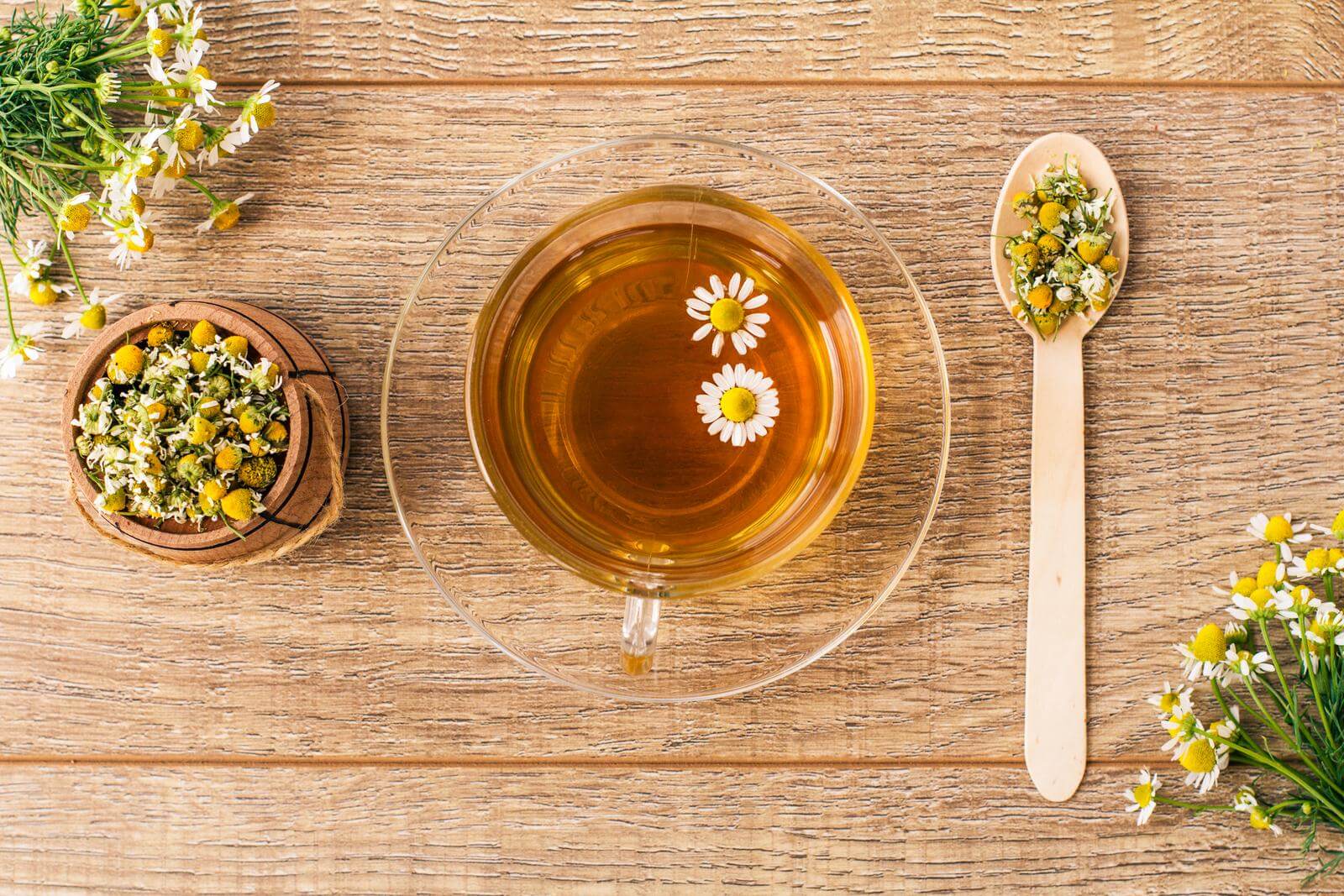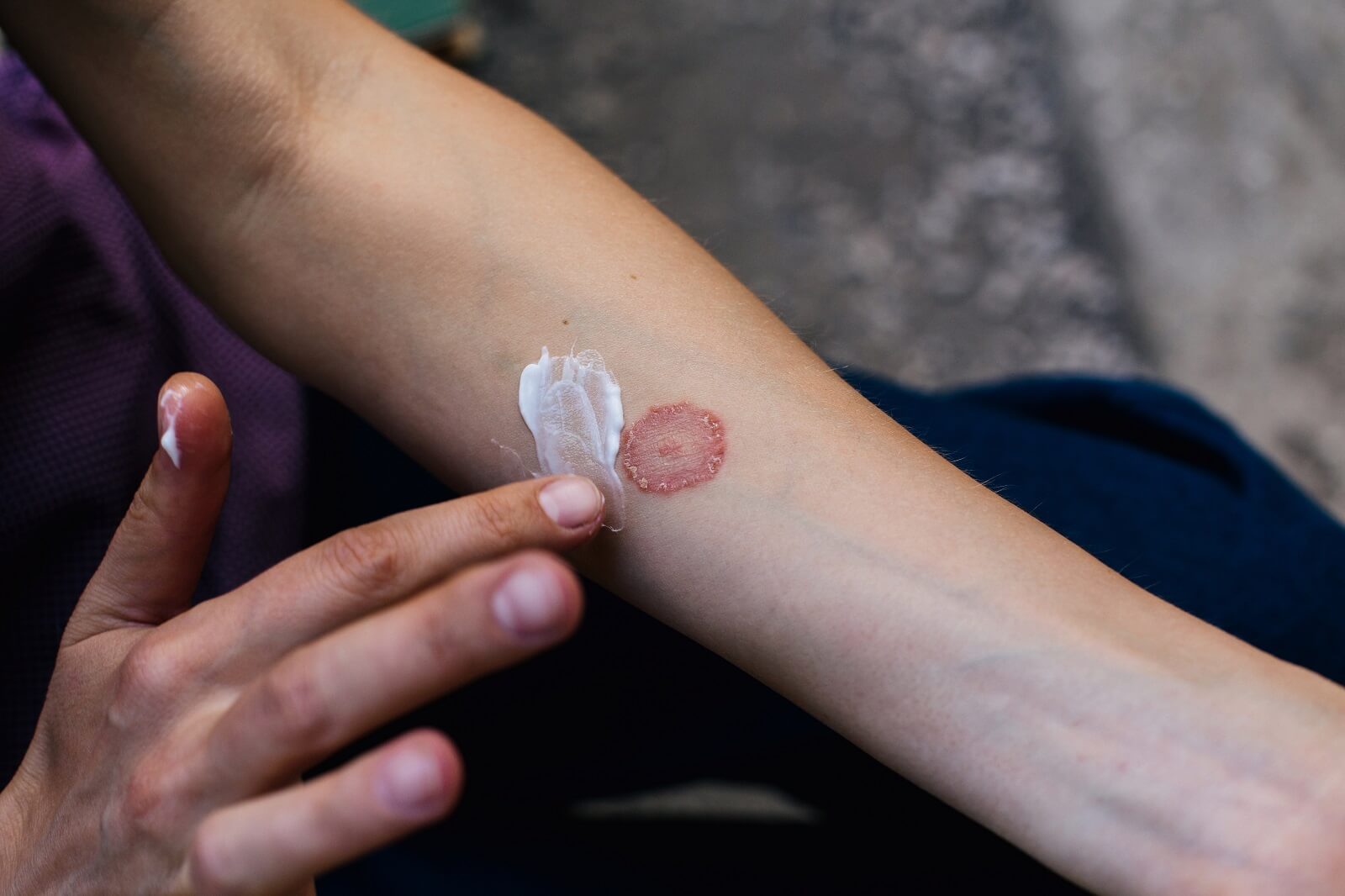
Chamomile (Matricaria chamomilla / Chamaemelum nobile) has been proven to be antifungal against fungi that cause common superficial infections. If you have a yeast infection, oral thrush, or some form of ringworm / tinea (such as athlete’s foot) this herb is a good choice. The reason is it fights Candida albicans (the fungus causing most yeast infections) and a prominent cause of ringworm: Trichophyton rubrum.
Later in this article we will cover the studies that demonstrate how chamomile inhibited (stopped the growth of) fungal species causing these common infections. Although there is limited research on a broad range of fungal species, it is reasonable to assume an inference can be made from the research that is available; that being chamomile will work similarly against other species in the same genera (a taxonomic genera is a grouping of species).
The prominent medicinal herb expert Dr. James A. Duke, in his book The Green Pharmacy Herbal Handbook,(source 1) notes there are two kinds of chamomile. German chamomile, known by the scientific name Matricaria chamomilla; and Roman chamomile, known by the scientific name Chamaemelum nobile. Dr. Duke said these two plants are nearly indistinguishable to an amature; but, you might prefer using German chamomile for medicinal purposes.
Dr. John Herzog (MD)
Dr. John Herzog, a "survival surgeon" from Maine explains what home remedies work best in a crisis situation.
This may be important in the event you require first-aid or are in an emergency situation without easy access to a hospital. Dr. John Herzog has assembled a large collection of home remedies for such scenarios.

Most Common Types of Fungal Infections
Because there are so many different kinds of fungal diseases, it is not possible to cover them all! Instead, this article will focus on the most common superficial infections that often don’t require heavy medical intervention. And, if you are interested in chamomile as an antifungal, you probably want to treat one of these fungal problems listed next.
According to the U.S. Centers for Disease Control and Prevention (CDC)(source 2) the most common types of fungal diseases are:
- Ringworm (medical terms for this condition are "tinea" and "dermatophytosis")
- Candida infections of the mouth, throat, and esophagus
- Vaginal Candida infections
- Fungal nail infections
Claire Goodall’s Amazing Guide
Clair Goodall is a bee-obsessed, natural medicine convert from Minnesota (USA). And, she does keep bees!
Clair has created 350+ page book documenting how to replace the toxic products and medications in your home with healthier, all-natural alternatives.

Ringworm (Tinea / Dermatophytosis)

Ringworm is a very common type of fungal infection, and is named according to where it occurs on the body. These infections are caused by a type of fungi known as dermatophytes. If you have an athlete’s foot infection, for example, then the medical term for this is tinea pedis.
According to a 2015 study in Current Fungal Infection Reports(source 3) dermatophytes are amongst the most common fungal pathogens causing superficial skin infections. Of these dermatophyte infections, Trichophyton rubrum (T. rubrum) has become the most frequent causal agent.
The study also states that dermatophytes are allocated into three very similar genera (a genera is a taxonomic grouping of species):
- Trichophyton
- Epidermophyton
- Microsporum
The study summarized the most common types of dermatophytosis and the fungal species behind the diseases. T. rubrum is one of the most common dermatophytes causing Athlete’s foot and nail fungal infections in North and Central America, Europe, the Middle East, and Asia.
A 2015 study in the Journal of Korean Medical Science(source 4) was done to investigate the epidemiological and clinical aspects of T. rubrum infections in Korea. According to this study, T. rubrum is the most common dermatophyte in the world.
The study found that the prevalence of T. rubrum infection increased from 1979 to 2013. Out of 131,122 patients with dermatophyte infections, during the study period, 88.35% of them were caused by T. rubrum. In 1979 T. rubrum caused 70.39% of dermatophyte infections and 94.28% in 2013. Additionally, the study states that T. rubrum has been the predominant cause of dermatophytosis, causing more than 90% of all instances of this infection since 1991.
Consequently, how an herb will affect T. rubrum is essential to understand one of the most important fungal pathogens causing skin infections. If an herb fights T. rubrum, it is going to be valuable to have on hand in many situations!

Comprehensive Herbalist School
Dr. Patrick Jones, founder of the HomeGrown Herbalist School of Botanical Medicine has been a practicing veterinarian for over 25 years. He is also a clinical herbalist and traditional naturopath.
Kevin Harrington, Original Shark from ABC’s Shark Tank, stands behind Dr. Patrick Jones and HomeGrown Herbalist.
Learn More
Comprehensive Herbalist School
Dr. Patrick Jones, founder of the HomeGrown Herbalist School of Botanical Medicine has been a practicing veterinarian for over 25 years. He is also a clinical herbalist and traditional naturopath.
Kevin Harrington, Original Shark from ABC’s Shark Tank, stands behind Dr. Patrick Jones and HomeGrown Herbalist.Learn More
A 2020 study in the Journal of Pure and Applied Microbiology(source 5) presented a picture of T. rubrum. This image is presented below:

The above picture shows Trichophyton rubrum. The picture on the left is a microscopic view of this dermatophyte fungus; and, the picture on the right is a view of it after it grew in a petri dish.
The picture was presented in a study in the Journal of Pure and Applied Microbiology 14.4 (2020). Creative Commons Attribution 4.0 International License.
How Chamomile Affects Dermatophytes
The same 2020 study in the Journal of Pure and Applied Microbiology,(source 5) that gives the aforementioned picture of T. rubrum, also tested chamomile on this fungus.
For their experiments, the study used a water based chamomile extract. To create this extract the complete flower head (including stems, stalks, bracts, and flowers) was used to make a powder. 40 g of this powder was mixed with 160 mL of distilled water. Using an electric blender, the plant material and water were blended and then the mixture was refrigerated for 24 hours. After further processing and centrifuging, the extract was created.
The study found that the chamomile extract reduced the growth of T. rubrum from the control (the control T. rubrum did not have any extract added to it and shows unhindered growth). The control sample of T. rubrum produced a growth diameter of 4.0 cm. Chamomile extract at 25°C at a concentration of 20 mg/mL reduced the growth diameter down to 0.5 cm.
A 2012 study in the Journal de Mycologie Medicale(source 6) tested German chamomile essential oil on medically important dermatophytes. The type of essential oil used was made from the flowers of German chamomile and prepared by hydrodistillation.
The study tested this essential oil against T. rubrum, Trichophyton mentagrophytes (T. mentagrophytes), Microsporum gypseum (M. gypseum), and other species of fungus, such as those in the Aspergillus genera. The fungi were cultured and allowed to incubate with the essential oil at various concentrations for 4 to 10 days at 28°C.

HomeGrown Herbalist Herb Shoppe
Owner of HomeGrown Herbalist Dr. Patrick Jones is a practicing veterinarian, Clinical Herbalist, and traditional naturopath. He owns and operates Fairview Animal Hospital in Buhl, ID.
Their herb shoppe provides herbs, essential oils, and tools. If you have some time, check it out!
Learn More
HomeGrown Herbalist Herb Shoppe
Owner of HomeGrown Herbalist Dr. Patrick Jones is a practicing veterinarian, Clinical Herbalist, and traditional naturopath. He owns and operates Fairview Animal Hospital in Buhl, ID.
Their herb shoppe provides herbs, essential oils, and tools. If you have some time, check it out!Learn More
Note that the study measured the concentration of essential oil in micrograms, which is abbreviated "mcg." 1 milligram (mg) is equal to 1000 micrograms. The German chamomile essential oil produced the following inhibition rates:
- For T. rubrum: 80 mcg/mL produced 100% growth inhibition.
- For T. mentagrophytes: 80 mcg/mL produced 96.6% growth inhibition.
- For M. gypseum: 80 mcg/mL produced 68.1% growth inhibition.
The study concluded that the German chamomile essential oil was a powerful inhibitor of all the 10 fungal species it was tested on. These fungal species were prominent pathogenic dermatophytes and saprophytes (saprophytes live on dead or decaying organic material).
Yeast Infections / Thrush - (Candida)

According to a 2020 study in Microorganisms(source 7) Candida is the fungus that causes vaginal yeast infections. Candida lives in the genital and urinary organs, respiratory system, and gastrointestinal tract of over 30% of healthy individuals in their lifetimes.
Additionally, vaginal yeast infections is the second most common type of vaginal infection; the most common being bacterial vaginosis (i.e., BV). Approximately 75% of all women will have a vaginal yeast infection at least once during their lives.
According to a 2016 study in Critical Reviews in Microbiology(source 8) the most common species of Candida that cause vaginal yeast infections are Candida albicans (C. albicans), Candida glabrata (C. glabrata), Candida parapsilosis, Candida krusei (C. krusei), and Candida tropicalis. Typically, a single species is responsible for a vaginal yeast infection; but, in about 1 to 10% of cases there will be more than one Candida species.
Concerning the prevalence of these Candida species, C. albicans is the most common species identified in cases of vaginal yeast infections. C. glabrata is the second most commonly identified cause.
The study also relates that in American, European, and Australian studies C. albicans was by far the most common cause of vaginal yeast infections; responsible for about 70 to 89% of the infections. C. glabrata was the second most common cause; causing 3.4 to 20% of cases.
As a result, when it comes to vaginal yeast infections, it is important to see how chamomile will affect C. albicans.
How Chamomile Affects Candida
A 2013 study in Industrial Crops and Products(source 9) tested chamomile (Matricaria chamomilla L.) extracts and essential oil against C. albicans.
Although the study made extracts with various solvents, ethanol (drinking alcohol) was used for one extract. The study also tested chamomile essential oil against C. albicans.
The study found that 20 mcg (20 micrograms) of chamomile ethanolic extract produced a zone of inhibition (ZOI; the area around a substance in which a microorganism will not grow in) of 21 mm. The study also tested a fennel extract; and, 20 mcg of it created a ZOI of 12 mm on C. albicans.
Concerning the essential oil of chamomile, the study found the minimum inhibitory concentration (MIC; the lowest concentration of a substance that will stop the growth of a microorganism) for this oil with C. albicans. The MIC of the chamomile essential oil was 10 mcg/mL. So this oil was quite effective.
The study also found the MIC of the ethanolic chamomile extract against C. albicans; it was 12.5 mcg/mL.
A 2015 study in the Indian Journal of Dentistry(source 10) evaluated the antimicrobial activity of German chamomile (Matricaria chamomilla) against C. albicans.

Comprehensive Herbalist School
Dr. Patrick Jones, founder of the HomeGrown Herbalist School of Botanical Medicine has been a practicing veterinarian for over 25 years. He is also a clinical herbalist and traditional naturopath.
Kevin Harrington, Original Shark from ABC’s Shark Tank, stands behind Dr. Patrick Jones and HomeGrown Herbalist.
Learn More
Comprehensive Herbalist School
Dr. Patrick Jones, founder of the HomeGrown Herbalist School of Botanical Medicine has been a practicing veterinarian for over 25 years. He is also a clinical herbalist and traditional naturopath.
Kevin Harrington, Original Shark from ABC’s Shark Tank, stands behind Dr. Patrick Jones and HomeGrown Herbalist.Learn More
For their experiments, the study used water as a solvent. For one extract hot water was used as a solvent, and for another extract cold water was used. Concentrations of 15 and 25% were then used for the antimicrobial experiments.
The study found that a 15% concentration of water based German chamomile extract did not produce any ZOI against C. albicans. Yet, the 25% concentration of this extract did; producing a 24.16 mm ZOI. The study concluded their results indicated 25% German chamomile extract could be used as an antimicrobial agent.
A 2015 study in the Indian Journal of Microbiology(source 11) tested a wide variety of essential oils against 48 isolates of different Candida species. One of the tested essential oils was Roman Chamomile (Chamaemelum nobile). 14 isolates were C. glabrata and 10 were C. krusei; and, these were all resistant to the popular antifungal drug fluconazole (brand name Diflucan).
The study did not report results for Roman chamomile as only the top 8 most effective antifungal oils were selected. The study said that the definite best antifungal activity was seen from cinnamon bark essential oil.
Consequently, Roman chamomile probably does not make the best antifungal. Instead, another essential oil with better ability should be used when treating Candida infections.
Chamomile for Nail Fungus (Onychomycosis)

According to a StatPearls overview(source 12) on the U.S. National Library of Medicine website, nail fungal infections (the medical term is onychomycosis) are most frequently caused by T. rubrum. Yet other dermatophytes, such as T. mentagrophytes and Epidermophyton floccosum can cause it as well. C. albicans also causes this infection, but this fungus only accounts for 2% of total infections.
Dermatophytes are isolated from 90% of toenail fungal infections and 50% of fingernail fungal infections. C. albicans nail infections occur mostly in the fingernails.
Thus, as chamomile is active against T. rubrum, and probably other dermatophytes, it is reasonable to assume that it can help with nail fungal infections. But, because of the results of the 2015 study in the Indian Journal of Microbiology,(source 11) it might be reasonable to assume other herbs will work better than chamomile for fungal infections.
Garlic is one known powerful antifungal. If I had a toenail fungal infection, I would turn to garlic, tea tree oil, and black walnut. Chamomile is not something I would use. Yes, it may be somewhat effective, but other herbal therapies are probably much more efficacious in such situations.
Side Effects of Chamomile
Common types of German and Roman chamomile flowers have the U.S. FDA’s generally recognized as safe (GRAS) status. Yet, there are some complications that can arise from chamomile to be aware of.
Chamomile might be able to induce labor by affecting the uterine muscles. And, chamomile may cause drug interactions with certain medications—such as the blood thinner warfarin. So, chamomile’s side effects and contraindications are more than just related to allergic reactions!
Herbsey has an entire article on the side effects of chamomile that also lists dosage guidelines. If you want to know how much chamomile to take, and situations where it probably isn’t safe, check out this article: Side Effects & Dosage Guidelines for Chamomile.
About the Author
Geoff Kent is a natural medicine enthusiast who has been researching and writing about natural medicine since 2008. Geoff is primarily a web developer, but also researches and authors written and video content about natural health. Geoff has a bachelor’s degree in Management Information Systems from the University of Northern Iowa.
More on Geoff KentImportant Disclosures & Disclaimers
It is important to use the information you find on Herbsey.com in the right way. Also for legal reasons, these disclaimers and disclosures are necessary. For further information about each, feel free to click the link provided to the page on this website that provides more information.
Medical Disclaimer
The information on this website is not a prescription for anyone. This information is for informational or educational purposes only, and is not a substitute for professional medical advice or consultations with healthcare professionals.
Advertisement Disclosure
Some of the links provided on this article and website are affiliate links. If you purchase a product after clicking on these links, Herbsey.com will earn a commission. Herbsey.com promotes various products through advertisement and text links. For more information: Our Advertisements.






